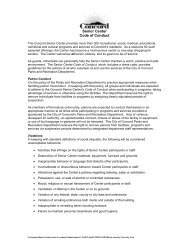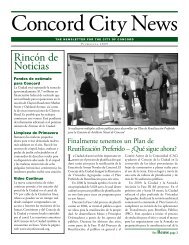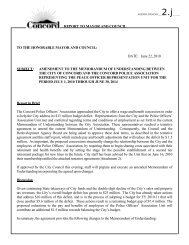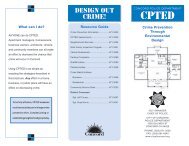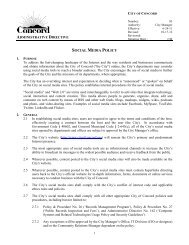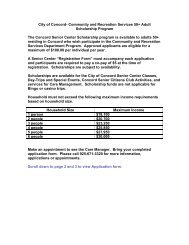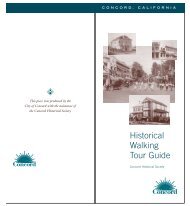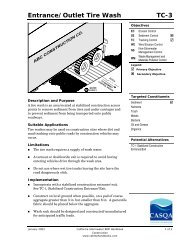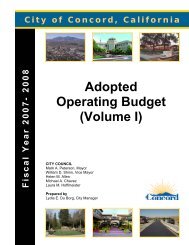You also want an ePaper? Increase the reach of your titles
YUMPU automatically turns print PDFs into web optimized ePapers that Google loves.
<strong>Sandbag</strong> <strong>Barrier</strong><strong>SE</strong>-8ObjectivesEC Erosion Control <strong>SE</strong> Sediment Control TR Tracking ControlWE Wind Erosion ControlNon-StormwaterNSManagement ControlWaste Management andWMMaterials Pollution ControlLegend: Primary Objective Secondary ObjectiveDescription and PurposeA sandbag barrier is a series <strong>of</strong> sand-filled bags placed on alevel contour to intercept sheet flows. <strong>Sandbag</strong> barriers pondsheet flow run<strong>of</strong>f, allowing sediment to settle out.Suitable Applications<strong>Sandbag</strong> barriers may be suitable:• As a linear sediment control measure:- Below the toe <strong>of</strong> slopes and erodible slopes- As sediment traps at culvert/pipe outlets- Below other small cleared areas- Along the perimeter <strong>of</strong> a site- Down slope <strong>of</strong> exposed soil areasTargeted ConstituentsSedimentNutrientsTrashMetalsBacteriaOil and GreaseOrganicsPotential Alternatives<strong>SE</strong>-1 Silt Fence<strong>SE</strong>-5 Fiber Rolls<strong>SE</strong>-6 Gravel Bag Berm<strong>SE</strong>-9 Straw Bale <strong>Barrier</strong>- Around temporary stockpiles and spoil areas- Parallel to a roadway to keep sediment <strong>of</strong>f paved areas- Along streams and channels• As linear erosion control measure:- Along the face and at grade breaks <strong>of</strong> exposed and erodibleslopes to shorten slope length and spread run<strong>of</strong>f as sheetflowJanuary 2003 California Stormwater BMP Handbook 1 <strong>of</strong> 6Constructionwww.cabmphandbooks.com
<strong>Sandbag</strong> <strong>Barrier</strong><strong>SE</strong>-8• Stack sandbags at least three bags high.• Butt ends <strong>of</strong> bags tightly.• Overlapp butt joints <strong>of</strong> row beneath with each successive row.• Use a pyramid approach when stacking bags.• In non-traffic areas- Height = 18 in. maximum- Top width = 24 in. minimum for three or more layer construction- Side slope = 2:1 or flatter• In construction traffic areas- Height = 12 in. maximum- Top width = 24 in. minimum for three or more layer construction.- Side slopes = 2:1 or flatter.Materials• <strong>Sandbag</strong> Material: <strong>Sandbag</strong> should be woven polypropylene, polyethylene or polyamidefabric, minimum unit weight <strong>of</strong> 4 ounces/yd 2 , Mullen burst strength exceeding 300 lb/in 2 inconformance with the requirements in ASTM designation D3786, and ultraviolet stabilityexceeding 70% in conformance with the requirements in ASTM designation D4355. Use <strong>of</strong>burlap may not acceptable in some jurisdictions.• <strong>Sandbag</strong> Size: Each sand-filled bag should have a length <strong>of</strong> 18 in., width <strong>of</strong> 12 in.,thickness <strong>of</strong> 3 in., and mass <strong>of</strong> approximately 33 lbs. Bag dimensions are nominal, and mayvary based on locally available materials.• Fill Material: All sandbag fill material should be non-cohesive, Class 1 or Class 2permeable material free from clay and deleterious material.Costs<strong>Sandbag</strong> barriers are more costly, but typically have a longer useful life than other barriers.Empty sandbags cost $0.25 - $0.75. Average cost <strong>of</strong> fill material is $8 per yd 3 . Pre-filledsandbags are more expensive at $1.50 - $2.00 per bag.Inspection and Maintenance• Inspect BMPs prior to forecast rain, daily during extended rain events, after rain events,weekly during the rainy season, and at two-week intervals during the non-rainy season.• <strong>Sandbag</strong>s exposed to sunlight will need to be replaced every two to three months due todegradation <strong>of</strong> the bags.• Reshape or replace sandbags as needed.January 2003 California Stormwater BMP Handbook 3 <strong>of</strong> 6Constructionwww.cabmphandbooks.com
<strong>SE</strong>-8<strong>Sandbag</strong> <strong>Barrier</strong>• Repair washouts or other damage as needed.• Sediment that accumulates in the BMP must be periodically removed in order to maintainBMP effectiveness. Sediment should be removed when the sediment accumulation reachesone-third <strong>of</strong> the barrier height. Sediment removed during maintenance may be incorporatedinto earthwork on the site or disposed at an appropriate location.• Remove sandbags when no longer needed. Remove sediment accumulation, and clean, regrade,and stabilize the area.ReferencesStormwater Quality Handbooks - Construction Site Best Management Practices (BMPs) Manual,State <strong>of</strong> California Department <strong>of</strong> Transportation (Caltrans), November 2000.4 <strong>of</strong> 6 California Stormwater BMP Handbook January 2003Constructionwww.cabmphandbooks.com
<strong>Sandbag</strong> <strong>Barrier</strong><strong>SE</strong>-8January 2003 California Stormwater BMP Handbook 5 <strong>of</strong> 6Constructionwww.cabmphandbooks.com
<strong>SE</strong>-8<strong>Sandbag</strong> <strong>Barrier</strong>6 <strong>of</strong> 6 California Stormwater BMP Handbook January 2003Constructionwww.cabmphandbooks.com



